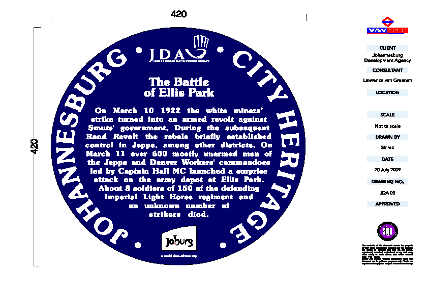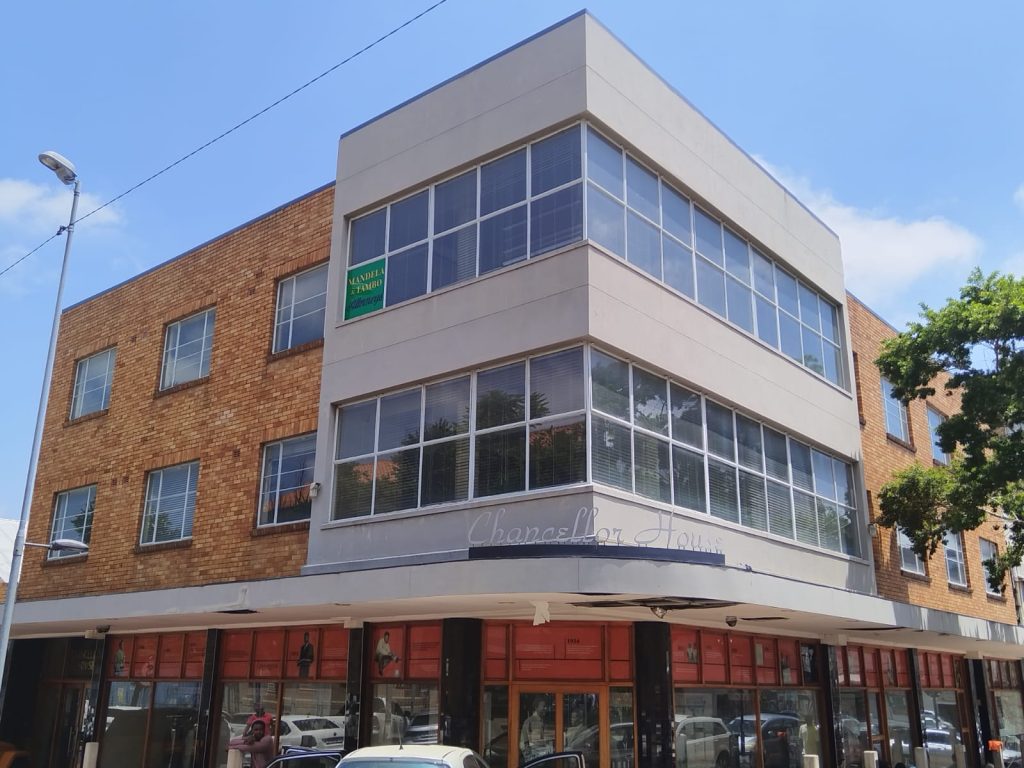Two rows of modest workers’ cottages making up a wedge (see attached plan) located on the east side of the Ellis Park sports complex. These semi-detached structures, known as the Erin Street cottages, were constructed between 1910 and 1914. “Semi detached” denotes a single structure consisting of two separate units joined together but separated from each other by a common or party wall. Such a pair of units is in turn separated from any adjoining unit by side spaces. The triangle of land, bounded by Erin street, Bertrams Road and Fritzroy Road, has situated on it 13 remaining dwelling units (originally 17).
Public Artwork
In 2009 a mosaic depicting a battle-scene was added to the eastern side of the cottages, together with a blue plaque, facing onto Bertrams Road. Together with the plaque, the artwork commemorates the 1922 battle site near the Ellis Park sport complex. The mural was designed by artist Andrew Lindsay, and created by a group of 10 homeless women from the CDP project in Bertrams.
The six stands were acquired by Thomas Douglas, one of Johannesburg’s pioneer builders and developers. Douglas lived in Fairview, where he owned extensive property. He made his fortune building and developing working class housing in Fairview and Doornfontein. Douglas developed similar housing in Fairview and probably built the next cottage as and when he had the spare capacity. He sold the cottages off to developers so obviously did not want to have to lease them out himself.
The Erin Street cottages were constructed ca. 1910-1914. According to the Valuation Roll of 1913 not all the cottages had been developed. Stands 483-485 had two on each and 487 only one. By 1925 Thomas Douglas had sold these to Charles Resnekowitz who presumably bought them as an investment. According to the Valuation Roll of 1925 there were still two stands undeveloped. That seems unlikely as the houses appear to be of very similar vintage.
The cottages were always occupied by tenants, and during the early years these would have been respectable working class people with well paid jobs who could afford good rentals. They were not slums until very much later when Doornfontein became downgraded and neglected.
Association with 1922 Strike: the Battle of Ellis Park
The battle fought in this vicinity was one of the early successes of the strikers and appears to have been part of a general strategy followed on Black Friday and the following day of surprise attacks on government forces.
It was a brave effort because although the strikers’ force consisted of men of both the Jeppe and Denver Commandos, perhaps 600 men, they had only 20 rifles between them. Some were armed with revolvers which were useless at any distance. They were vastly outgunned by the government forces.
The Imperial Light Horse had been assigned a football field at Ellis Park as an equipping camp. It was positioned about 20 feet below the level of the roadways which commanded the position and separated from the drain (the small stream which runs through the valley) by a hedge. Godley commented: “Not a wise choice in my opinion as it lies in a basin surrounded by rising ground and circled with houses”.
Godley was not quite correct regarding the houses, as the closest houses at this time would have been the cottages in the triangle. The other houses would have been much further off. No pickets seem to have been positioned and according to Herd the troops were drawing stores. Major Rennie said they were responding to the trumpeter’s “Come to the cookhouse boys”.
At around 1:00 pm in broad daylight, the strikers attacked from three sides, and in a very short time 8 soldiers lay dead and about 35 wounded. Some of the Imperial Light Horse ad received their rifles and opened fire and were able eventually to drive the strikers back, but they certainly did not suffer the 47 dead boasted by Major Rennie at the Commission of Enquiry.
The attack had been led by Captain Hall, a strike leader who certainly understood military tactics since he held the Military Cross.
“A woman living in one of the cottages overlooking the camp said she heard a noise in Park Lane (Park Street) and looking out, observed people coming down the street. A small detachment armed with rifles, got into the culvert and began shooting over the hedge. Another body of men took possession of one of the cottages”.
The ILH troops were volunteers and Major Rennie calculated that some of the young recruits who reported for service at 1 pm that day found themselves under fire within half an hour.
Significantly, the Strikers had organized ambulance services. Col. Panchaud testified that “several of the Revolutionary Red Cross motor cars and horse trolleys were picking up their dead and their wounded …” While the battle was going on, the Fordsberg Police received a complaint from a strike leader that the troops were firing on his Red Cross men. (Krikler 2005).

General Protection under Section 34 of the National Heritage Resources Act (NHRA). This relates to structures older than sixty years

A culmination of research gathered over many years, the Online Johannesburg Heritage Register is being launched on Nelson Mandela Day 18 July 2025.
Among the many heritage sites featured is Chancellor House, the downtown offices of Mandela and Tambo Attorneys in the 1950s. After having been vacant and shuttered for more than a decade, this iconic building is being revived and brought to life once again as offices for the Community Development Department, which oversees the City’s Arts, Culture & Heritage Services.